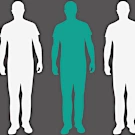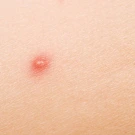8 Things Your Nipples Say About Your Health
Hairy nipples aren't as weird as you might think.

LAURENT HAMELS/GETTY IMAGES
Nipples aren't just decorative—but you already knew that. Something you may not have known: Your nipples can clue you in to some serious health problems.
If you notice sudden puckering or dimpling of the skin around or on your nipple—particularly if it occurs around just one nipple—call your doctor. This could be a warning sign of breast cancer.
Here are 7 more things you need to know about your nipples:

TRICIA SHAY PHOTOGRAPHY/GETTY IMAGES
1. NIPPLE DISCHARGE IS OFTEN NORMAL—EVEN IF YOU'RE NOT PREGNANT OR BREASTFEEDING.
This discharge (milky, bluish-green, or clear) can occur in most women if the nipple is squeezed, explains Leah S. Gendler, MD, a breast surgeon at Morristown Medical Center in New Jersey. But if you're not squeezing—and especially if the discharge is bloody and/or coming from just one of your breasts—see a health care professional, Gendler advises. The discharge could be the result of a benign growth, a harmless cyst, or breast cancer.

PETER LAMMERTZEN / EYEEM/GETTY IMAGES
2. THIRD NIPPLES ARE MORE COMMON THAN YOU'D THINK.
According to one estimate, up to 27.2 million Americans have a third nipple somewhere on their body. These "supernumerary" nipples are often mistaken for moles or skin tags. Having a third nipple isn't a problem, and it can easily be removed in an outpatient procedure, explains plastic surgeon Grace Ma, MD, of Peachtree Plastic Surgery in Atlanta. "The entire procedure takes about 30 minutes," she says, "and recovery is minimal."
MORE CONTENT
 Visit Venice's Scuola Grande Di S. MarcoExplore Italy
Visit Venice's Scuola Grande Di S. MarcoExplore Italy Nearly Half Of Men Have This STDWomen's Health
Nearly Half Of Men Have This STDWomen's Health Finland attracts health startupsinvestinfinland
Finland attracts health startupsinvestinfinland 'Yes, That’s Acne On Your Vagina—Here’s How To Treat It'Women's Health
'Yes, That’s Acne On Your Vagina—Here’s How To Treat It'Women's Health Neue Ära der Aufzugtechnik revolutioniert die GebäudekonstruktionURBAN HUB
Neue Ära der Aufzugtechnik revolutioniert die GebäudekonstruktionURBAN HUB STIs In Women: 9 Things You Never Knew About STIsWomen's Health
STIs In Women: 9 Things You Never Knew About STIsWomen's Health
FEAR OF MISSING OUT?
DON'T MISS OUT ANYMORE!
You may unsubscribe at any time.

PHILIP HAYNES/GETTY IMAGES
3. EXERCISE CAN CHAFE NIPPLES.
A well-fitting sports bra helps, as do non-chafing balms or round Band-Aids applied to the nipples. But if you're not doing vigorous activity and notice your nipples are red, itchy, scaly, and/or flaking, see your doctor. This could be a sign of Paget's disease, a rare form of cancer involving the nipple and areola, Gendler says. She adds: "It could also be eczema, so don't get anxious. Just have your doctor assess."
Learn how to do a breast self-exam:
How to do a Breast Self-Exam
Look for these abnormalities during your next home checkup
0:02
/
1:53
Loaded: 0%

RGBDIGITAL/GETTY IMAGES
4. HAIRY NIPPLES ARE NORMAL—EVEN IN WOMEN.
Those small bumps around the nipples are normal hair follicles. If you've got dark hairs growing on your nipples, pluck, wax, or cut them carefully. If these hair follicles become painful, grow in size, or are itchy and scaly, see your doctor. It could be a sign of infection—or cancer.

MONASHEE ALONSO/GETTY IMAGES
5. NIPPLE PAIN DURING BREASTFEEDING IS COMMON (AND PREVENTABLE).
Throbbing, burning, cracked, or sore nipples are all common complaints, particularly in the first few weeks of breastfeeding. But if this pain continues, consult a breastfeeding specialist; your baby may not be latching on properly. Engorged breasts can also trigger nipple pain, as can an infection of the nipples triggered by bacteria or Candida yeast, says one Australian study.

CLIVE STREETER/GETTY IMAGES
6. INVERTED NIPPLES ARE NO CAUSE FOR CONCERN.
About 15% of women have inverted nipples from birth, says Z. Paul Lorenc, MD, a plastic surgeon in New York City. "It's a simple matter of connective tissue retracting the nipple inward," he explains. "It's a relatively minor surgical procedure to correct it. We make a tiny incision to release the connective tissue, and the nipple pops out. We can do both nipples under local anesthesia in about an hour."
RELATED: APPARENTLY THERE ARE 7 TYPES OF BOOBS—WHICH DO YOU HAVE?

LEKCEJ/GETTY IMAGES
7. NIPPLES ARE EROGENOUS ZONES FOR WOMEN (AND FOR SOME GUYS, TOO).
According to researchers at Rutgers University, the sensation from nipple stimulation travels to the same pleasure centers of the brain as sensations from the vagina, clitoris, and cervix. Piercing fans, take note: Nipple piercings may lead to loss of sensation due to nerve damage.
No comments:
Post a Comment